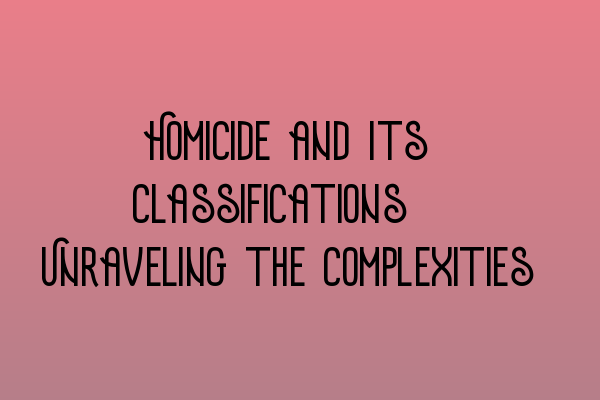Homicide and Its Classifications: Unraveling the Complexities
Welcome to the SQE Criminal Law & Practice Law UK blog! In this article, we will delve into the intricate world of homicide and its various classifications. Homicide is a serious crime that demands a comprehensive understanding of the law. So, let’s explore this complex topic together.
Definition of Homicide
Homicide, at its core, refers to the unlawful killing of one person by another. It is a broad category that encompasses different types of killings, each with its own legal implications. Understanding these classifications is crucial for any aspiring legal professional.
Classification of Homicide
Homicide can be categorized into three main classifications: murder, manslaughter, and infanticide. Each classification is defined by specific elements and intent, which play a significant role in determining the charges and severity of punishment.
Murder
Murder involves the intentional killing of another person with malice aforethought. Malice aforethought implies a deliberate and premeditated act, demonstrating the perpetrator’s clear intent to cause fatal harm. Murder is considered the most severe form of homicide and carries harsh penalties, including life imprisonment.
To understand the concept of murder better, consider reading our related article on Understanding Murder in Criminal Law.
Manslaughter
Manslaughter differs from murder in that it lacks the element of malice aforethought. It involves unlawfully causing the death of another person but without premeditation or intent to cause fatal harm. Manslaughter can be further classified into two categories: voluntary manslaughter and involuntary manslaughter.
Voluntary manslaughter occurs when a person commits a killing in the heat of passion, provoked by a reasonable and adequate provocation. Involuntary manslaughter, on the other hand, involves unintentional killing resulting from reckless or negligent behavior.
To dive deeper into the concept of manslaughter, take a look at our article on Understanding Manslaughter Charges in Criminal Law.
Infanticide
Infanticide is a unique classification of homicide specific to the killing of an infant by their mother within a year of giving birth. The law recognizes that this offense is often influenced by postnatal depression or related disorders. Infanticide carries relatively lighter penalties than murder or manslaughter but still holds serious legal consequences.
For more information about infanticide and its legal nuances, check out our dedicated article on Understanding the Crime of Infanticide.
Conclusion
Homicide is a multifaceted area of criminal law that demands a deep understanding of its classifications and legal implications. By grasping the differences between murder, manslaughter, and infanticide, legal professionals can navigate the complexities of homicide cases and strive for justice.
At SQE Criminal Law & Practice Law UK, we provide comprehensive preparation for aspiring legal professionals. Whether you are preparing for the SQE 1 or SQE 2 exams, we offer SQE 1 Preparation Courses and SQE 2 Preparation Courses to help you build a strong foundation in criminal law.
Looking for practice materials to assess your knowledge? Check out our SQE 1 Practice Exam Questions and SQE 1 Practice Mocks FLK1 FLK2 for an interactive learning experience.
Stay updated on the latest SRA SQE exam dates by visiting our article on SRA SQE Exam Dates.
We hope this article has shed light on the complexities of homicide and its classifications. Remember, a solid understanding of criminal law is essential for any legal professional, and SQE Criminal Law & Practice Law UK is here to guide you on your journey.
